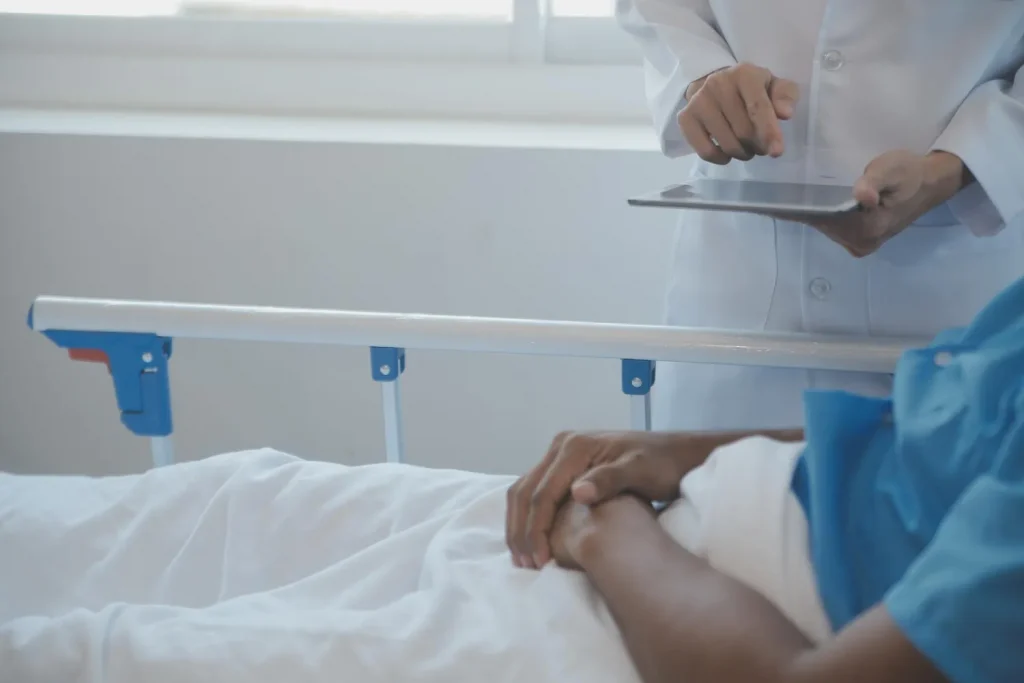
Partial Hospitalization Programs (PHP) play a crucial role in the course of addiction treatment, offering a structured and supportive environment that bridges the gap between inpatient and outpatient services.
For patients requiring intensive care without the need for full hospitalization, PHPs provide a lifeline. They offer crisis stabilization, management of acute symptoms, and comprehensive therapy while allowing patients to return home each day. These programs also facilitate adjustments in pharmacotherapy, conduct skills training, and foster group psychotherapy.
Though research is still limited, data suggests that PHPs may significantly improve patient satisfaction within the first year post-discharge. Read on to learn more about the benefits of PHP treatment for addiction treatment and acute mental health issues.
Table Of Contents:
- What Is Partial Hospitalization Program (PHP)?
- What Is A Partial Hospitalization Program Like?
- How Long Does Partial Hospitalization Last?
- How Much Is Partial Hospitalization Program?
- Partial Hospitalization Program Requirements
- Does Insurance Cover Partial Hospitalization?
- Finding PHP Near Me
- PHP Program – Bottom Line
- People Also Ask

What Is Partial Hospitalization Program (PHP)?
A Partial Hospitalization Program (PHP), previously known as “day hospitals,” is a specialized form of outpatient treatment designed for individuals dealing with serious mental health or substance use disorders. According to Congress, PHPs are intended for patients who require intensive care but do not need round-the-clock supervision.
These programs aim to improve a patient’s condition or maintain their functional level, preventing relapse or needing full hospitalization. Endorsed by organizations like the National Association of Psychiatric Health Systems (NAPPH) and the American Association for Partial Hospitalization (AAPH), PHPs are a critical component of the recovery course.
Typically offered by hospitals as structured and organized ambulatory services, allow patients to receive daily, intensive treatment while still returning home at the end of the day. A PHP program can:
- Shorten the duration of inpatient stays
- Facilitate a smoother transition from inpatient to outpatient care
- Helps avoid hospitalization altogether
- Stabilize a patient during a crisis
- Make strength-based future planning and continued recovery-oriented work
Placement in a PHP is a clinical decision that must be made by a physician well-versed in the patient’s medical history, environment, and support system. PHPs offer a balanced approach to treatment, combining the intensity of inpatient rehab with the flexibility of outpatient services.
PHP vs IOP
When choosing a treatment program for mental health or addiction issues, understanding the differences between Partial Hospitalization Programs (PHP) and Intensive Outpatient Programs (IOP) is crucial. Both PHPs and IOPs offer structured care but differ in intensity and daily involvement. Find below a concise comparison:
| Aspect | Partial Hospitalization Program (PHP) | Intensive Outpatient Program (IOP) |
|---|---|---|
| Level of Care | More intensive, with daily or near-daily sessions | Step-down level of care with more flexibility |
| Session Duration | 6–8 hours per session | 2–4 hours per session |
| Frequency | Daily or near-daily (5–7 days a week) | 3–5 days a week |
| On-Site Medical Supervision | Often included | Less focus on medical supervision |
| Focus | Includes on-site medical supervision and intensive support | Structured therapy with a focus on group work |
| Transition | Ideal for those transitioning from residential treatment | Suitable for those stepping down from more intensive treatment or with less severe issues |
| Cost | Generally more expensive due to higher intensity and longer sessions | Typically less expensive compared to PHP |
| Insurance Coverage | Often covered by insurance; check for specific details | Often covered by insurance; check for specific details |
What Is A Partial Hospitalization Program Like?
PHPs deliver intensive treatment focused on stabilizing acute symptoms. Through a crisis-oriented approach, patients learn to identify triggers, understand their crisis, and develop new coping strategies.
PHPs also emphasize a recovery-focused mindset. They teach patients that recovery is non-linear, with ups and downs, helping them set realistic expectations. During PHP treatment, patients typically spend 6 to 8 hours each day at a treatment facility, often five to seven days a week.
Although there is no universal definition of the elements, a standard PHP schedule may include:
Daily Schedule
A typical day in a PHP begins in the morning and ends in the late afternoon, with patients returning home each evening. PHP covers individual therapy, group sessions, and educational workshops.
Patients might start the day with a group check-in, sharing their progress and challenges with peers and therapists. This is followed by various therapeutic activities, including cognitive-behavioral therapy (CBT), dialectical behavior therapy (DBT), or other evidence-based practices.
Therapeutic Activities
PHPs offer a blend of individual and group therapy, where patients address personal issues with a therapist and get peer support while developing social skills.
Many programs also include family therapy to involve loved ones in recovery. Additionally, patients engage in educational sessions on life skills, coping strategies, relapse prevention, and activities like mindfulness, art therapy, and stress management to enhance overall well-being.
Medical Care
In addition to therapy, PHPs provide medical management for those who need it. This might involve regular monitoring of medication, adjustments to treatment plans, and access to psychiatrists or other medical professionals who can address any physical or co-occurring disorders that arise during treatment.
How Long Does Partial Hospitalization Last?
The length of a partial hospitalization program (PHP) can vary depending on the individual’s needs and progress. Research also suggests it varies according to the type of program (substance use disorder vs. mental health issues).
Old data from 1999 shows that partial hospitalization in the treatment of borderline personality disorder lasted 1.45 years. Still, recent research found that military patients completed a 6-day partial hospitalization program within 2 years.
Due to the complex nature of the disorder and the multifaceted nature of the services provided, treatment typically requires several weeks to months. On average, a PHP must last at least 2 weeks. Some people may benefit from a shorter or longer stay, and the length of stay is assessed weekly with your clinician.
Factors that can affect the rehab length include:
- Individuals requiring more intensive support and complex treatment may require an extended stay.
- Those transitioning from a higher level of care, like residential treatment, may benefit from a shorter stay.
- Insurance coverage can also affect the length of stay.
How Much Is Partial Hospitalization Program?
The cost of a partial hospitalization program (PHP) can vary widely, depending on several factors, including:
- Regions/cities where the PHP is affects the cost. Urban centers are more expensive than rural areas.
- The length of the can impact the cost, with longer programs generally incurring higher expenses.
- The intensity/complexity of the care needed, including medical supervision and therapeutic interventions.
- The range of therapies includes individual and group therapy, family counseling, and specialized treatments.
- The extent of rehab coverage, out-of-pocket expenses or co-pays can significantly impact the cost.
On average, you can expect to pay between $350 and $450 per day for a PHP in a private care facility, which typically lasts several weeks to a few months. Some facilities may offer sliding-scale fees or financial assistance options based on income level.
Partial Hospitalization Program Requirements
As full-time outpatient programs, PHPs are designed for medically stable people, have at-home support systems, are not at risk of self-harm or harming others, and are motivated to participate in treatment.
People who might benefit from a PHP include those who:
- Are in a stable medical condition
- Are willing to participate in treatment
- Aren’t at risk of self-harm or violence toward others
- Can’t deal with triggers at home, work, school, or other daily environments
- Have other forms of support for treatment and rehabilitation
- Don’t require or cannot receive 24-hour monitored inpatient programs
- Have time and commitment to attend the program
- Don’t have active suicidal thoughts
- Need a more structured environment and support to maintain safety
- Live in a stable residence
- Volunteer to participate in the program
Does Insurance Cover Partial Hospitalization?
Most insurance companies cover partial hospitalization programs (PHPs) as a necessary component of mental health and addiction treatment under the Affordable Care Act (ACA). Still, they may require preauthorization, and you may need to meet certain requirements.
For example, you may need prior authorization from your primary care physician (PCP) or provide your insurance information to a potential clinic. You may also need a letter of medical necessity. The rehab costs will vary depending on the type of health plan you have. If you have a high deductible plan, you may need to pay more out-of-pocket before insurance coverage kicks in.
Contact your insurance agent for comprehensive details and to fully understand the extent of your coverage, particularly if you’re new to indemnity insurance.
Finding PHP Near Me
Finding a Partial Hospitalization Program (PHP) near you involves several steps to ensure you choose the right facility for your needs. Here’s a guide to help you in your search:
- Talk to a healthcare provider for recommendations based on your condition.
- Check with local hospitals and clinics offering PHPs in your area.
- Contact your insurance provider for a list of covered PHP facilities near you.
- Use online directories to search for mental health and substance abuse treatment facilities.
- Look for reviews and testimonials online from former patients on Google Reviews or Yelp.
- Consider visiting the facilities or calling them to ask questions about their programs and staff qualifications.
PHP Program – Bottom Line
Partial Hospitalization Programs (PHPs) offer a crucial bridge between inpatient and outpatient care, providing intensive, structured support for individuals with mental health or addiction issues. While PHPs are highly effective for many, not all patients are suitable for this level of care.
Good candidates can find in PHPs a strong foundation for long-term recovery. PHPs engage patients in active treatment planning and align their personal and treatment goals, empowering patients to take an active role in their healing journey.
If you or a loved one is facing mental health or addiction challenges, exploring PHPs could be the right step toward recovery. Contact healthcare providers or local rehab centers to learn more about the PHP options available.
People Also Ask
What is a PHP program?
A Partial Hospitalization Program (PHP) is an intensive, structured treatment program offering therapy and medical care for mental health or addiction issues without requiring overnight stays.
What happens in a partial hospitalization program?
Patients receive daily therapy, counseling, and medical monitoring, focusing on stabilizing symptoms, developing coping strategies, and preparing for less intensive care.
What is the difference between PHP and IOP?
PHP provides more intensive care with longer daily sessions for more severe conditions, while IOP offers shorter, less frequent sessions suitable for less severe issues or as a step-down from PHP.
Find Drug Rehabilitation Centers Near You Anywhere In the US
Addiction Resource team has compiled an extensive list of the top drug rehabilitation facilities around the country. Use our locator tool to find the best centers near you.
Page Sources
- Khawaja, I. S., & Westermeyer, J. J. Providing Crisis-oriented and Recovery-based Treatment in Partial Hospitalization Programs. Psychiatry (Edgmont), 7(2), 28-31. https://www.ncbi.nlm.nih.gov/pmc/articles/PMC2848466/
- Horvitz-Lennon, M., et al. (2001). Partial versus full hospitalization for Adults in Psychiatric Distress: A Systematic Review of the Published Literature (1957–1997). American Journal of Psychiatry, 158(5), 676–685. https://doi.org/10.1176/appi.ajp.158.5.676
- Definition of partial hospitalization. The National Association of Private Psychiatric Hospitals and the American Association for Partial Hospitalization. PubMed. https://pubmed.ncbi.nlm.nih.gov/10106610/
- Durbin, K. M., et al. (2017). Partial hospitalization: Are treatment effects maintained post-discharge? The Brown University Child and Adolescent Behavior Letter, 33(1), 1-6. https://doi.org/10.1002/cbl.30181
- Bateman, A., & Fonagy, P. (1999). Effectiveness of partial hospitalization in the treatment of borderline personality Disorder: a randomized controlled trial. American Journal of Psychiatry, 156(10), 1563–1569. https://doi.org/10.1176/ajp.156.10.1563
- Murphy, J. W., Corey, L. C., & Sturgeon, M. J. (2022). Evaluation of outcomes for military mental health partial hospitalization program. Military Psychology, 34(1), 91-97. https://doi.org/10.1080/08995605.2021.1971939
- Blevins, C. E., et al. (2017). Alcohol treatment outcomes following discharge from a partial hospital program. Journal of Substance Use, 22(6), 643. https://doi.org/10.1080/14659891.2017.1296041
- Average Cost of Drug Rehab [2023]: by Type, State & More. (2024, May 2). NCDAS. https://drugabusestatistics.org/cost-of-rehab/
- Isola, S., & Reddivari, A. K. R. (2023, July 10). Affordable Care Act. StatPearls - NCBI Bookshelf. https://www.ncbi.nlm.nih.gov/books/NBK549767/


 Reviewed by:
Reviewed by:  Written by:
Written by: 
 FindTreatment.gov
FindTreatment.gov